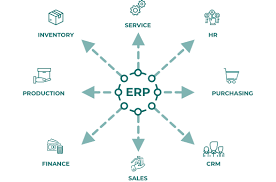ERP Development: Streamlining Business Processes for Success
In today’s fast-paced business environment, organizations face numerous challenges in managing their operations efficiently. One solution that has proven to be highly effective is Enterprise Resource Planning (ERP) systems. ERP development has revolutionized the way businesses operate by integrating various functions and processes into a centralized system.
ERP development involves designing and implementing software solutions that enable organizations to streamline their operations, enhance productivity, and improve overall efficiency. These systems provide a comprehensive view of an organization’s resources, including finance, human resources, supply chain management, customer relationship management, and more.
One of the key advantages of ERP development is the ability to automate manual tasks and eliminate redundant processes. By integrating different departments and functions into a single platform, data can flow seamlessly across the organization. This eliminates the need for multiple standalone systems and reduces data entry errors and inconsistencies.
Furthermore, ERP systems enable real-time data analysis and reporting. With accurate and up-to-date information readily available, decision-makers can make informed choices based on reliable insights. This empowers organizations to respond swiftly to market changes, identify trends, optimize resource allocation, and make strategic decisions that drive growth.
Another significant benefit of ERP development is improved collaboration among teams. By centralizing data and processes, employees from different departments can access relevant information from a single source. This promotes cross-functional collaboration, enhances communication, and fosters teamwork across the organization.
Moreover, ERP systems facilitate better inventory management by providing real-time visibility into stock levels, demand patterns, and supplier performance. This enables organizations to optimize inventory levels, reduce carrying costs, minimize stockouts or overstocking situations while ensuring timely deliveries to customers.
Security is also a critical aspect of ERP development. These systems implement robust security measures to protect sensitive business data from unauthorized access or breaches. Data encryption techniques are employed to safeguard information throughout its lifecycle within the system.
However beneficial ERP development may be for an organization, it is essential to recognize that implementing an ERP system requires careful planning, customization, and training. Each organization has unique requirements and processes that need to be considered during the development phase. Therefore, it is crucial to engage with experienced ERP developers who can tailor the system to meet specific business needs.
In conclusion, ERP development has become a game-changer for businesses seeking to optimize their operations and achieve sustainable growth. By integrating various functions into a centralized system, organizations can streamline their processes, enhance collaboration, improve decision-making, and gain a competitive edge in the market. The benefits of ERP systems are numerous, including increased efficiency, improved data accuracy, enhanced customer satisfaction, and cost savings. With the right ERP development partner and a well-executed implementation plan, organizations can unlock their full potential and pave the way for long-term success.
Common Questions about ERP Development: A Comprehensive Guide
- What are the 5 components of ERP?
- How is an ERP system developed?
- Why ERP is developed?
- What is ERP software development?
What are the 5 components of ERP?
The five components of ERP (Enterprise Resource Planning) typically include:
- Human Resources Management (HRM): This component focuses on managing employee-related processes such as recruitment, onboarding, payroll, benefits administration, performance management, and training. It helps organizations effectively manage their workforce and ensure compliance with labor laws and regulations.
- Supply Chain Management (SCM): SCM is responsible for the efficient planning, sourcing, procurement, production, and distribution of goods and services. It encompasses activities like inventory management, demand forecasting, supplier relationship management, order fulfillment, logistics coordination, and warehouse management. SCM aims to optimize the flow of materials and information across the supply chain to meet customer demands while minimizing costs.
- Financial Management: This component deals with financial processes such as general ledger accounting, accounts payable/receivable management, budgeting, asset management, cash flow analysis, financial reporting, and compliance with accounting standards. It provides organizations with accurate financial data for decision-making purposes and ensures regulatory compliance.
- Customer Relationship Management (CRM): CRM focuses on managing customer interactions throughout the sales cycle—from lead generation to post-sales support. It includes functionalities like contact management, sales force automation, marketing campaign management, customer service/support tracking systems, and analytics for customer insights. CRM helps organizations build strong customer relationships by understanding their needs and preferences.
- Manufacturing/Operations Management: This component is primarily concerned with managing production processes efficiently. It involves functions such as production planning/scheduling, shop floor control/monitoring, quality control/assurance, equipment maintenance tracking/systems integration (often through IoT), product lifecycle management (PLM), and real-time data collection for analysis/improvement purposes.
These five components work together within an integrated ERP system to provide a holistic view of an organization’s resources and operations. By connecting different functional areas into a single platform and facilitating seamless information flow across departments in real-time or near real-time basis, ERP systems help organizations optimize their processes, improve decision-making, and achieve operational excellence.
How is an ERP system developed?
Developing an ERP (Enterprise Resource Planning) system involves several stages and requires a systematic approach. Here is a general overview of the typical steps involved in ERP system development:
- Requirement Analysis: The first step is to gather detailed requirements from the organization. This involves understanding the business processes, identifying pain points, and determining the specific functionalities and modules required in the ERP system.
- Planning and Design: Based on the requirements, a comprehensive plan is created outlining the project scope, timeline, resource allocation, and budget. The system architecture is designed, including database structure, user interfaces, workflows, and integration points with other systems.
- Customization or Configuration: Depending on the specific needs of the organization, customization or configuration of the ERP system takes place. Customization involves modifying the software code to meet unique requirements, while configuration involves tailoring existing features and settings within the system.
- Development: The actual development of the ERP system begins at this stage. Developers write code to implement the planned architecture and design specifications. This includes creating database tables, building user interfaces, implementing business logic, integrating modules, and ensuring data integrity.
- Testing: Thorough testing is crucial to ensure that the ERP system functions as intended and meets all requirements. Different types of testing are performed such as unit testing (testing individual components), integration testing (testing interactions between different modules), functional testing (verifying functionalities), performance testing (assessing system response under various loads), and user acceptance testing (validating against user expectations).
- Deployment: Once development and testing are completed successfully, it’s time to deploy the ERP system in a production environment. This involves installing hardware infrastructure if necessary, configuring servers or cloud environments for hosting the application, migrating data from legacy systems if applicable, and setting up user access privileges.
- Training and Documentation: Users need to be trained on how to effectively use the new ERP system for their day-to-day tasks. Training sessions are conducted to familiarize users with the system’s features, workflows, and best practices. Additionally, comprehensive documentation is created to serve as a reference guide for users and administrators.
- Post-Deployment Support: After the ERP system is deployed, ongoing support and maintenance are necessary. Bug fixes, updates, security patches, and system enhancements may be required based on user feedback or evolving business needs.
It’s important to note that ERP system development is a complex and iterative process that requires collaboration between developers, business analysts, project managers, and end-users. Each organization’s requirements may vary, so the development approach should be tailored accordingly to ensure a successful implementation of the ERP system.
Why ERP is developed?
ERP (Enterprise Resource Planning) is developed to address the challenges and complexities faced by organizations in managing their operations effectively. Here are some key reasons why ERP systems are developed:
- Integration: ERP systems are designed to integrate various departments and functions within an organization into a centralized platform. By consolidating data and processes, ERP eliminates data silos and enables seamless communication and collaboration across different departments.
- Streamlining Operations: ERP development aims to streamline business operations by automating manual tasks, eliminating redundant processes, and optimizing workflows. This leads to increased efficiency, reduced errors, and improved productivity.
- Data Management: ERP systems provide a comprehensive view of an organization’s resources, including finances, inventory, human resources, sales, customer information, supply chain management, and more. By centralizing data management, ERP ensures accurate and up-to-date information is readily available for decision-making.
- Improved Decision-Making: With real-time data analysis and reporting capabilities, ERP systems enable organizations to make informed decisions based on reliable insights. Decision-makers can access critical information quickly and easily to identify trends, track performance metrics, optimize resource allocation, and respond promptly to market changes.
- Enhanced Customer Relationship Management (CRM): CRM functionality within ERP systems allows organizations to manage customer interactions effectively. It enables businesses to track customer data, preferences, purchase history, and provide personalized services or targeted marketing campaigns.
- Supply Chain Management: ERP development includes features that facilitate efficient supply chain management by optimizing procurement processes, managing inventory levels accurately, tracking shipments in real-time, improving supplier relationships, reducing lead times, and ensuring timely deliveries.
- Regulatory Compliance: Many industries have specific regulations that organizations must adhere to. ERP systems can be customized to incorporate compliance requirements into their workflows. This helps organizations ensure they meet legal obligations while minimizing the risk of non-compliance.
- Scalability: As businesses grow or change over time, ERP systems can be scaled and customized to accommodate evolving needs. This flexibility allows organizations to adapt their ERP solution to match their expanding operations or changing business models.
- Data Security: ERP development focuses on implementing robust security measures to protect sensitive business data from unauthorized access or breaches. This includes encryption techniques, user access controls, data backup strategies, and disaster recovery plans.
In summary, ERP systems are developed to integrate and streamline business processes, improve data management and decision-making, enhance customer relationship management, optimize supply chain operations, ensure regulatory compliance, provide scalability options, and prioritize data security. These benefits contribute to increased efficiency, productivity, and competitiveness for organizations across various industries.
What is ERP software development?
ERP software development refers to the process of designing, building, and implementing customized software solutions known as Enterprise Resource Planning (ERP) systems. ERP software development involves creating a comprehensive and integrated platform that centralizes and automates various business processes within an organization.
The goal of ERP software development is to provide organizations with a unified system that seamlessly integrates different departments and functions, such as finance, human resources, supply chain management, customer relationship management, manufacturing, inventory management, and more. By consolidating these processes into a single software solution, ERP systems enable efficient data flow and real-time information sharing across the organization.
During the ERP software development process, developers work closely with businesses to understand their specific requirements and tailor the system accordingly. This customization ensures that the ERP system aligns with the organization’s unique processes and workflows. Developers may also integrate additional modules or functionalities based on specific industry needs or business goals.
Key aspects of ERP software development include:
- Analysis: Developers assess the organization’s current processes and identify areas for improvement or automation. They collaborate with stakeholders to define project goals, scope, and requirements.
- Design: Based on the analysis, developers create a blueprint for the ERP system’s architecture and functionality. This includes designing user interfaces, data structures, workflows, reporting mechanisms, security protocols, and integration points.
- Development: Developers write code to build the ERP system according to the design specifications. They develop modules for different functions such as finance, HR, inventory management, etc., ensuring seamless integration between them.
- Testing: Rigorous testing is conducted to ensure that the ERP system functions properly under various scenarios. This includes functional testing (e.g., verifying calculations), performance testing (e.g., assessing response times), security testing (e.g., checking access controls), and user acceptance testing (e.g., validating usability).
- Deployment: Once testing is complete and any necessary refinements have been made based on feedback, the ERP system is deployed to the organization’s infrastructure. This involves installation, configuration, and data migration.
- Training and Support: ERP software development includes providing training and support to users to ensure they can effectively utilize the system. Ongoing technical assistance and maintenance are also offered to address any issues or updates that may arise.
ERP software development aims to streamline operations, improve efficiency, enhance collaboration, enable better decision-making through real-time data insights, and ultimately drive business growth. By leveraging customized ERP systems, organizations can optimize their processes and gain a competitive advantage in their respective industries.




